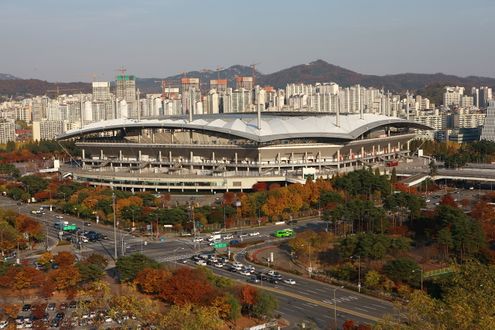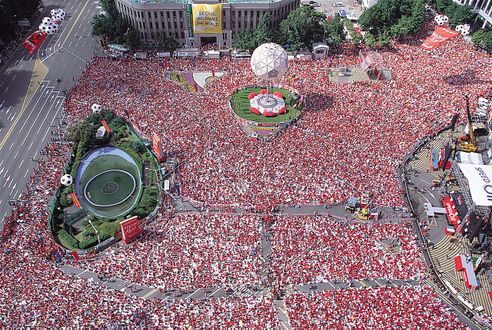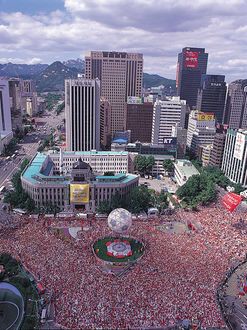The 2002 Korea-Japan World Cup
The 17th FIFA World Cup held from May 31 to June 30, 2002, is an unforgettable event for South Koreans because their whole nation "became one" under the name "Red Devils" and showed their passion to the world.
South Korea and Japan became the co-hosts of the event by the decision of the FIFA Executive Committee. As a result, the 17th World Cup became the first World Cup to be held on the Asian continent as well as the only World Cup to be jointly hosted by more than one country. Its official title was the "2002 FIFA World Cup Korea/Japan" and its official theme was "New Millennium, New Encounter, and New Start."
The South Korean national team led by Guus Hiddink, a Dutch-born coach and manager, had 7 wins, 2 losses, and 3 draws, and achieved a historic fourth-place finish.
South Korea's cheering culture during the World Cup attracted the world's attention. Thousands of Koreans in red T-shirts poured into the streets, cheering for the underdog South Korean national team. The collective street-cheering was coordinated and led by a supporters club called the "Red Devils." The "Red Devils" was a non-governmental, non-profit, and apolitical group originally organized during the 1998 France World Cup to support the national team. The name Red Devils came from the nickname "Red Furies," coined by the international media in 1983 when the South Korean youth team reached the semi-finals of the 1983 World Youth Championship in Mexico.
The South Korean people's passion was explosive during the 2002 World Cup games. The Red Devils coordinated massive street-cheering in public sites, watching the games together and cheering in one voice. Regardless of their age and gender, people in red t-shirts gathered in Seoul City Plaza, Gwanghwamum Plaza, and Daehangno Avenue as well as local schools and sports-fields nationwide where jumbo screens were installed specifically for mass viewing.
At the beginning of the 2002 World Cup, there were 500,000 fans participating in the Red Devils club. However, as the South Korean national team got closer to the semi-final, more Koreans joined. By the end of the World Cup, 7 million people, which was 20% of the entire South Korean adult population, participated in the street-cheering. In other words, it became a sports festival not only for soccer fans but for the whole nation. Now, street-cheering has become a symbol of the Korean support culture, especially for the national team during subsequent FIFA World Cups.
The 2002 World Cup Korea/Japan presented an opportunity for Korea to strengthen its global stature. Furthermore, the passionate cheering and support the Korean fans demonstrated raised the level of Korean soccer, and also united and gave confidence to the people.
Related Articles
- 2002 FIFA World Cup Korea/Japan
- Guus Hiddink
- 1983 World Youth Championship
- Red Devils
- Seoul City Plaza
- Gwanghwamum Plaza
- Daehangno Avenue


